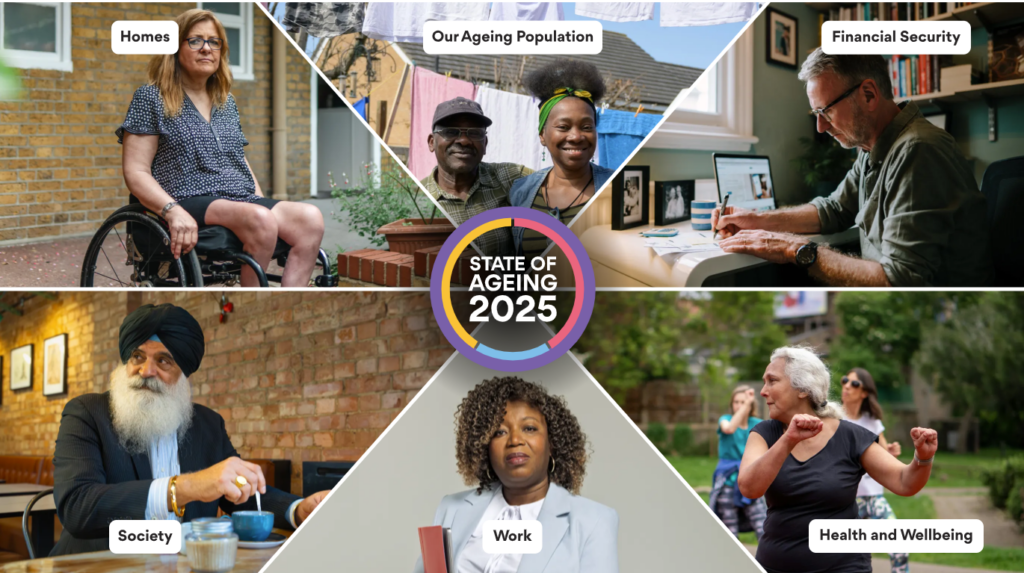The latest research by The Centre for Aging better, State of Ageing 2025 report finds that living in the poorest parts of England can cost you almost five years of your life.
We will be focussing on, and discussing the report findings in more detail over the coming weeks and months but you can click on the button below to read a detailed summary.
Financial security
Being in work is a key determinant of financial security in later life. It allows you to pay National Insurance contributions that entitle you to your State Pension, and you can contribute to an occupational pension and accrue other savings. After State Pension age, income is comprised of pension income (State Pension and occupational pensions) and savings, although some pensioners may have additional sources of income.
For the least well-off pensioners, the majority of their income comes from the State Pension and other benefits. But the UK has one of the lowest State Pension provisions of all OECD countries and, despite the triple lock, the State Pension does not provide pensioners in this country with a basic standard of living, even when it is topped up by pension credit. Pensioner couples on the full State Pension can only reach 91% of the Minimum Income Standard (an estimate of the income needed for people to have a socially acceptable standard of living) or 87% for those receiving pension credit. A single pensioner can only reach 94% of the income required, whether they are receiving the full State Pension or a top-up via pension credit.
For many pensioners, occupational pensions can supplement the income they receive from the State. Auto-enrolment into occupational pensions has transformed the pension landscape but employment histories that comprise either part-time work or low pay mean that many people do not meet the £10,000 per year threshold for auto-enrolment.
Others opt out of workplace pensions to maximise in-work income. And there is a large variation in the receipt of occupational pensions across the country, from 67% of pensioners in London to 82% of pensioners in the South West. Almost twothirds (64%) of self-employed people, six in ten (58%) people from minority ethnic backgrounds and half (50%) of disabled people have no private pension savings by the time they reach the age of 60 to 6532. Occupational pension income ranges from just £37 per week, on average, for pensioner couples in the bottom 20% of the pensioner income distribution to £748 per week for those in the top 20%. And one in eight people above State Pension age has no income apart from their State Pension and other benefits.
Savings can act as a buffer for pensioners with no employment income but one in ten pensioners
has no savings at all. Overall, we see enormous inequality in pensioner incomes, inequality that has increased over time. During the past ten years, there has been an 11% rise in the net weekly income of the most well-off single pensioners, compared with just 1% for the least well-off.
At this time 17% of pensioners are in relative poverty, rising to one in five pensioners aged 85 and over36. In addition, almost one in ten (8%) pensioners are in material deprivation (they don’t have enough money to afford key essentials such as keeping their home warm, being able to pay bills regularly, having at least one filling meal a day and a warm coat), a rate that has increased by two percentage points in the year to 2022/2337. This means that in 2022/23 an additional 300,000 older people were unable to afford the basics they need compared with the year before. And there is great regional inequality in the number of pensioners unable to afford the basics – 120,000 in London, 111,000 in the North West and 49,000
in the East Midlands.
The imminent increase of the State Pension age to 67 risks making pensioner poverty worse – the poverty rate of 65-year-olds doubled at the last increase to age 66. A raised pension age puts greater pressure on people to work for longer, so it will undoubtedly have an impact on the employment rates of the over-55s. While this helps the government achieve its 80% employment rate, it is those from poorer backgrounds, who have lower levels of pension income and other savings and are more likely to be in poor health, who will be most affected. Because they lack the financial resources to leave the workforce earlier than State Pension age, they will have to work through periods of ill health, which risks worsening their health further.
At the same time, healthy life expectancy is falling, raising the prospect of an increasing number of years out of work due to poor health with no pension income, or a greater number of years in work while managing poor health.
Without concerted efforts to improve employment rates for people in their sixties, and to improve support for people managing health conditions in the workplace, increasing the State Pension age will widen the wealth and health gap between the richest and poorest pensioners even further.
Our homes also play a role in the overall picture of pensioner poverty. Private renting is a risk factor for poverty because renting increases the level of income needed to cover housing costs. With rates of private renting into later life increasing, this trend runs the risk of reducing pension adequacy across the population in the long term. But home ownership is no guarantee of financial security, even when there is no mortgage. In fact, 12% of homeowners aged 65 and over are in poverty. The need to maintain their homes can place considerable financial pressure on older people who have fixed incomes and no savings.
“I will probably have to work until I’m 67 because that’s when I’ll get my State Pension. I actually don’t have a work pension because many, many moons ago when, you know, you look at life through rosecoloured glasses – “I won’t be working in my sixties, I’ll have married, I’ll have a family” – I opted out of a workplace pension. I’ve been working since I was 16. I’m nearly 62 now, and I don’t have a pension to show for it…”
Woman in her sixties, Knowsley
What needs to happen...
National government: Commit to pause increases to the State Pension age until there is a plan in place to ensure that any changes do not push significant numbers of people into poverty
National government: Review State Pension levels and associated benefits to ensure fewer pensioners are forced to live in material deprivation, unable to afford the basic necessities
for a dignified life.





